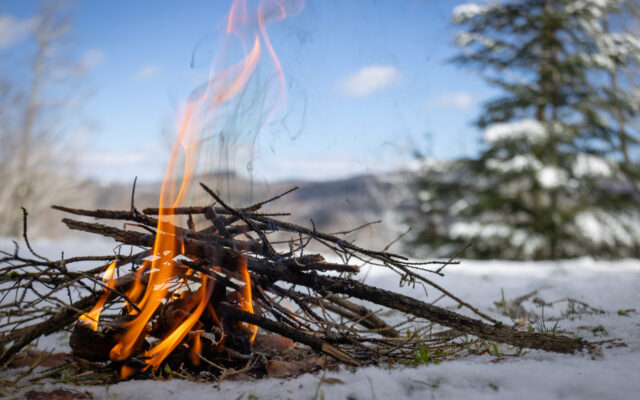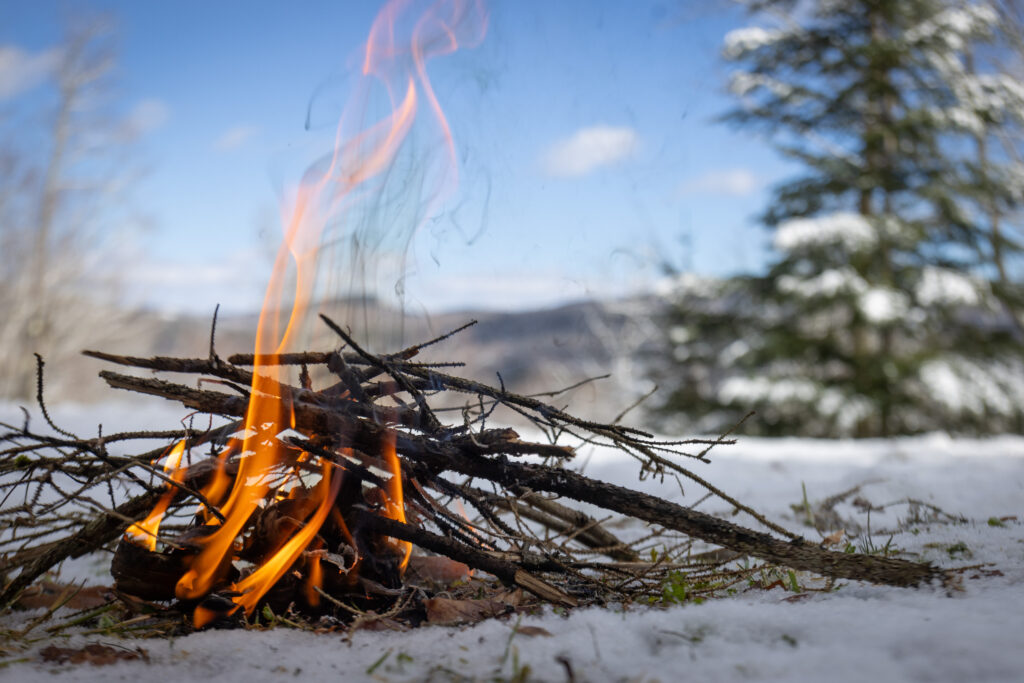
One skill and a tiny tool could save your life in the outdoors
By Aislinn Sarnacki
Every winter, I read about hikers who died on snowy mountains not far from my home.
As an avid hiker, I think long and hard about these tragedies, searching for a way that things could have unfolded differently. What could have saved the person? Wearing ice cleats? Packing an extra jacket? Carrying a map? Hiking with a friend?
This line of thinking recently led me to ponder a crucial skill: fire building. On a cold winter night, having the means and knowledge to build a small campfire just might save your life.

LIFESAVING — Having the tools and knowledge to build a small campfire could save your life in an emergency situation, especially in the winter.
Fire provides warmth, but it also increases your visibility so that rescue teams can find you. It offers you a way to boil and sterilize water, and cook food.
But perhaps most importantly, fire has a way of instilling goodwill. And ask any survivalist, a good attitude goes a long way in a stressful situation.
I’ve gleaned fire-building tips from bushcraft workshops, primitive skills festivals and conversations with skilled survivalists over the years. I’d like to pass on that knowledge to you.
First, whether you’re hiking or engaged in some other form of outdoor exploration, it’s crucial that you carry a fire-starting tool. Examples of fire starters include waterproof matches, a pocket lighter and a spark-producing device made of flint and steel, of which there are many varieties.
Fire starters are small and weigh next to nothing, so there’s no excuse to wander the wilderness without one. I suggest carrying two.
Next, when building an emergency campfire, you may not have a lot of options. But if you can build it next to a boulder or cliff, the rock could block the wind. Avoid puddles and soggy areas.
You can prepare the ground by clearing away brush, leaf litter and duff. In winter, you can either clear snow away to reach bare ground or make a platform of living-green wood. The goal is for the surface to be as dry as possible.
Now it’s time to gather materials, such as dry wood, to fuel your fire. It’s key to gather plenty of materials before you even think about striking a match. You don’t want to have to leave a tiny, flickering flame unattended while you scramble for more wood to feed it and chance it going out.
Collect wood of all sizes, from tiny twigs to big branches. The dryer, the better. Dead wood, if not sodden, is often best. Some types of wood, such as dead evergreen trees, catch fire and burn quickly. Their needles crackle delightfully, too. Hardwoods such as oak burn more slowly.
Look for dead standing trees, such as spruce. Also, break off the dead lower branches of live spruce and fir trees for firewood.
This process of collecting wood is important for several reasons. One is that it gives you a task that could help calm your mind. It also gets you moving, which helps keep your body warm.
Sort your burn materials into piles of small, medium and large pieces of wood, making it easy to grab the size you need as you build your fire. You’ll start with small pieces and work your way up as the flames grow.
Last but not least, you’ll need tinder, which is a bundle of dry, loose material that’s highly flammable. This is where you’ll aim your spark or first flame.
Many people carry tinder in their backpacks as a companion to their fire starter tool. Others count on being able to find enough natural materials to create a tinder ball in the wilderness.
One of the most popular tinder items I’ve heard of is dryer lint or cotton balls smothered in Vaseline, which contains flammable petroleum. (Place this in a plastic bag so you don’t make a mess of your backpack.)
When I recently posted a query about fire building on social media, I received several helpful tricks, but this reply from Brooks, stood out:
“Back in the ‘70s, we used to take a can, like a tuna fish can, wrap cardboard around inside it, pour paraffin wax over all, maybe put a couple of string wicks up through it, light it off, add bark, fluff, typical kindling, and go. And when done, the can goes out with you.”
Another type of DIY tinder item, shared from Camden, can be made by pouring candle wax and sawdust into cardboard egg carton cups.
Tea candles, which burn for several minutes, can be helpful when it comes to lighting a campfire, shared a Maine Scoutmaster.
A quick internet search turns up all sorts of ready-made tinder items, from treated ropes of cotton to cubes, tubes, sheets and sticks of mystery materials meant to burn slowly in inclement weather.
Personally, I’ve tried none of them.
By far, the best tinder I’ve found is natural, and it’s all over Maine: birch bark. Shred it into tiny, thin strips — the smaller the better — and ball it up underneath a tent of dry twigs. Dry cedar bark will also do in a pinch. Dried pinecones can help.
And a plea, if I may: If you’re not in an emergency situation, please don’t strip bark off of live trees. There are usually plenty of fallen trees in the Maine woods to harvest it from.
Also, if it’s not an emergency, be sure to follow the campfire rules of the property you’re on. Many preserves don’t permit campfires, while others allow them only in designated rings and with a permit. Be sure to extinguish your fire fully with water when done. Forest fires can cause a lot of damage.
You may have noticed that I didn’t talk about how to build a bow drill, which is a primitive tool made of wood and cordage that can be used to create an ember that leads to a fire.
That’s because making and using a bow drill is a challenging bushcraft skill. I know. I’ve tried it. It’s much easier to carry a lighter, matches or flint and steel. Trust me.
If you’ve got a tried and true fire-building technique to share, send me an email. I’d love to hear it.
For those new to fire building, try it in your backyard. Experiment with different fire starters and types of tinder and kindling. Get comfortable with it.
In Greek mythology, the god Prometheus got in a ton of trouble with his fellow gods for giving fire to man. It’s a powerful tool, and it’s easy to carry as you travel the wilderness.